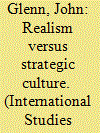|
|
|
Sort Order |
|
|
|
Items / Page
|
|
|
|
|
|
|
| Srl | Item |
| 1 |
ID:
090960


|
|
|
|
|
| Publication |
2009.
|
| Summary/Abstract |
The objective of this literature review is to understand where Graphical Information Systems (GIS) can be useful to address security issues and how it has been used until now. While the geographic drivers of territorial conflicts have been extensively described by a number of political studies, the quantitative analysis of these drivers is quite new. This study traces an evolution from conceptual research to quantitative development. It then discusses the advantages and challenges of applying new geographic techniques to analyze spatial drivers of conflict. We identify the main spatial components in conflict and security, the existing types of information/data and the quantitative methods used. We describe the spatial component of security by looking at: (i) the main sociopolitical concepts linked to territory, (ii) the kind of geographic concepts linked to territory, (iii) measures used to describe such geographic concepts; and (iv) the issues raised in any attempt to integrate geographic concepts into a GIS. We conclude that GIS tools can be useful in the analysis of civil disputes, particularly where subnational level data exists. This paper shows that spatial processing tools in GIS allow us to represent some spatial components and to address new issues such as the fuzzy complexity of border permeability.
|
|
|
|
|
|
|
|
|
|
|
|
|
|
|
|
| 2 |
ID:
090958


|
|
|
|
|
| Publication |
2009.
|
| Summary/Abstract |
The challenge of orchestrating coordination and cooperation among the many international organizations active in international development has attracted much interest from academics and practitioners alike. This study addresses a particular piece of the larger puzzle: as nongovernmental organizations (NGOs) and their donors, each usually with much different policy orientations, coalesce within interorganizational networks, what determines whose policy preferences are pursued, implemented, and delivered on the ground? Within the network-based model of NGO behavior introduced in this article, certain attributes and the internal institutional composition of NGO-donor policy networks are significant determinants in shaping opportunities for NGOs and in giving both NGOs and donors leverage over the policy process. The model focuses specifically on demonstrating the effects of a network on NGO autonomy-that is, an NGO's ability to advance its own policy preferences regardless of their congruency with those of its donors. The network typology presented in this study identifies the comparative advantages of distinct network types in which the NGO is most empowered as an autonomous policy actor and is best equipped to withstand parochial donor preferences. Using network analysis and the proposed network-based model, this research takes the form of a comparative study of four NGO-donor policy networks from the postconflict microfinance sector in Bosnia and Herzegovina. The study also charts new research paths toward developing network-based approaches to the study of international institutions.
|
|
|
|
|
|
|
|
|
|
|
|
|
|
|
|
| 3 |
ID:
090961


|
|
|
|
|
| Publication |
2009.
|
| Summary/Abstract |
This paper takes as its starting point the possibility of empirical and theoretical cross-fertilization between strategic culturalists and realists. Indeed, recent neoclassical realist writings indicate that there is currently a move away from the more abstract theorizing of Waltzian neorealism. In order to conduct detailed foreign policy analysis, these authors have included an increasing array of variables including nonmaterial factors. The paper argues that much can be gained from examination of the alternative explanations of state behavior provided by strategic culture and neoclassical realism. Yet the benefits of competitive collaboration depend upon the particular conception of strategic culture under consideration. The paper identifies four main conceptions of strategic culture and examines the type of collaboration with neoclassical realism that is possible for each one.
|
|
|
|
|
|
|
|
|
|
|
|
|
|
|
|
| 4 |
ID:
090962


|
|
|
|
|
| Publication |
2009.
|
| Summary/Abstract |
As constructivists and other advocates of constitutive theories have often noted, the natural world is very different from the social one. Our ideas about the social world not only reflect that world, but help shape and create it; we are part of the reality we try to describe and explain, and we therefore have the potential to alter the reality a theory is merely intended to describe or explain. Our theories about the social world may thus become self-fulfilling prophecies or autogenetic in character, or they may self-negate. And yet while social constructivists often make this point in epistemological debates, there have been relatively few attempts so far to address its empirical implications. With that objective in mind, this paper examines two prominent IR theories-the democratic peace and the commercial peace-arguing that each has a self-fulfilling character rather than being true or false in any objective or timeless sense, as well as the potential of a currently self-negating thesis-the clash of civilizations-to become self-fulfilling; each theory is, to paraphrase the now time-honored expression, what the relevant actors make of it. The article also probes the processes by which theories become self-generating or self-negating. It is suggested that a number of frameworks developed outside political science-especially diffusion theory, memetics, social contagion theories, George Lakoff's metaphor-based model, Malcolm Gladwell's "Tipping Point" approach and social network analysis-may in combination help us understand both how political ideas spread through academic and policy communities and why particular ideas "win out" over others.
|
|
|
|
|
|
|
|
|
|
|
|
|
|
|
|
| 5 |
ID:
090956


|
|
|
|
|
| Publication |
2009.
|
| Summary/Abstract |
Transnational public-private partnerships (PPPs) have become a popular theme in International Relations (IR) research. Such partnerships constitute a hybrid type of governance, in which nonstate actors co-govern along with state actors for the provision of collective goods, and thereby adopt governance functions that have formerly been the sole authority of sovereign states. Their recent proliferation is an expression of the contemporary reconfiguration of authority in world politics that poses essential questions on the effectiveness and the legitimacy of global governance. In this article, we critically survey the literature on transnational PPPs with respect to three central issues: Why do transnational PPPs emerge, under what conditions are they effective, and under what conditions are they legitimate governance instruments? We point to weaknesses of current research on PPPs and suggest how these weaknesses can be addressed. We argue that the application of IR theories and compliance theories in particular opens up the possibility for systematic comparative research that is necessary to obtain conclusive knowledge about the emergence, effectiveness, and legitimacy of transnational PPPs. Furthermore, the article introduces the concept of complex performance to capture possible unintended side effects of PPPs and their implications on global governance.
|
|
|
|
|
|
|
|
|
|
|
|
|
|
|
|
|
|
|
|
|